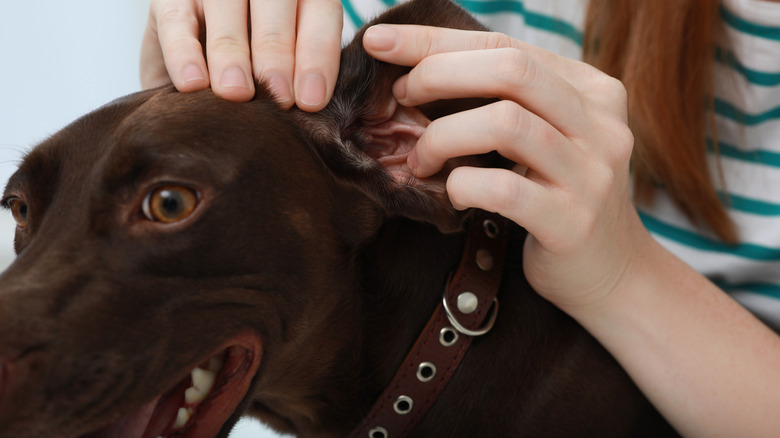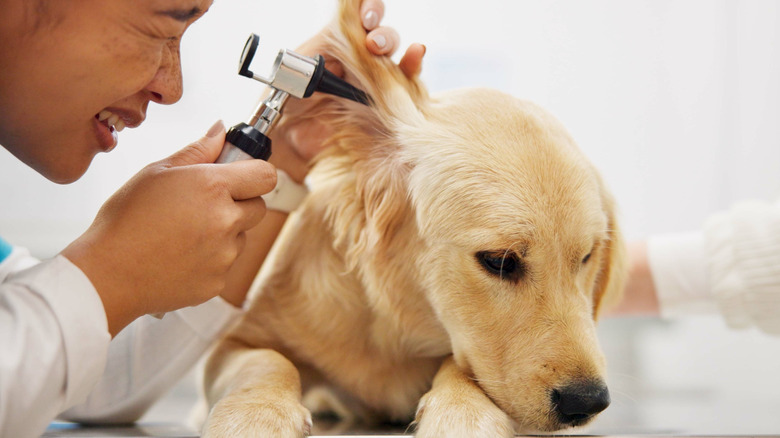These Symptoms Are Warning Signs That Your Dog Has An Ear Infection
We may receive a commission on purchases made from links.
Ear infections, specifically external infections known as otitis externa, are the third most common condition diagnosed in dogs, according to Banfield's 2020 State of Health Report. While any breed is prone to an ear infection, those with floppy or hairy ears, such as cocker spaniels and basset hounds, or breeds prone to allergies, like bulldogs and golden retrievers, face a higher risk. When symptoms first appear, this condition is a primary concern for pet parents and veterinarians.
Some telltale signs of outer ear infections include redness and swelling accompanied by an odor and excessive itchiness around the ears. Sometimes, a canine may experience nausea, vomiting, drooling, or additional eye discharge if the infection moves to their inner ear, per VCA Canada. Movements such as head shaking or leaning to one side when walking are also warning signs that a dog may be suffering from an inner ear infection. With a wide range of potential signs, it becomes essential for owners to understand how the condition occurs, when it is urgent, and how to treat it.
Checking a dog for ear infections
The buildup of bacteria, yeast, or wax in the ear canal can lead to an infection. There are multiple ways that bacteria can become present, including getting caught up in hair, moisture from a bath or swimming, a scratch, or allergies, making it important to know how often you should clean your dog's ears. In some cases, the signs of an ear infection can point to more significant issues like an injury or a tumor.
Checking your dog's ears at least once a week will help ensure they are comfortable with the process and allow you to look for any signs of an infection. For ears with lots of hair, you may want to consider trimming it or scheduling grooming to ensure the area can be inspected. With a clear view of the ear, pet parents should look for any discharge, redness, irritation, inflammation, or blood. Inflammation to the point of ballooning with high heat could indicate an aural hematoma and requires immediate follow-up with a veterinarian.
The odor that arises from an infected ear, if caused by a canine yeast infection, has a sweet or musty smell similar to the famous "Frito feet" found on dog paws. Alternatively, a bacterial infection may smell differently, or cause excessive pain, discharge, or inflammation in the ear. When symptoms do appear, it is crucial to avoid trying to clean an ear that is already infected. Doing this can cause further spread or damage. It's best to consult with a veterinarian on how to proceed.
How to treat dog ear infections
When symptoms of an ear infection are present, a veterinarian will try to gauge the cause by asking questions ranging from an owner's home treatment of the ear to your dog's current diet. Afterward, they will perform an examination, usually with a tool called an otoscope, that helps them visually look inside the canal. They may also take a swab of any debris to determine the type of infection. Once the specifics are determined and an infection is diagnosed, the veterinarian may prescribe medication, ear drops, and a thorough cleaning.
The veterinarian will also advise pet parents on any follow-up care. Some owners may choose to make home remedies to treat canine ear infections. Those wanting a veterinarian-formulated product, such as VetWELL Otic Rinse, can find options to purchase online. If you've noticed your dog is prone to ear infections, taking preventative measures, watching for signs, and properly following up with any treatment will help.


